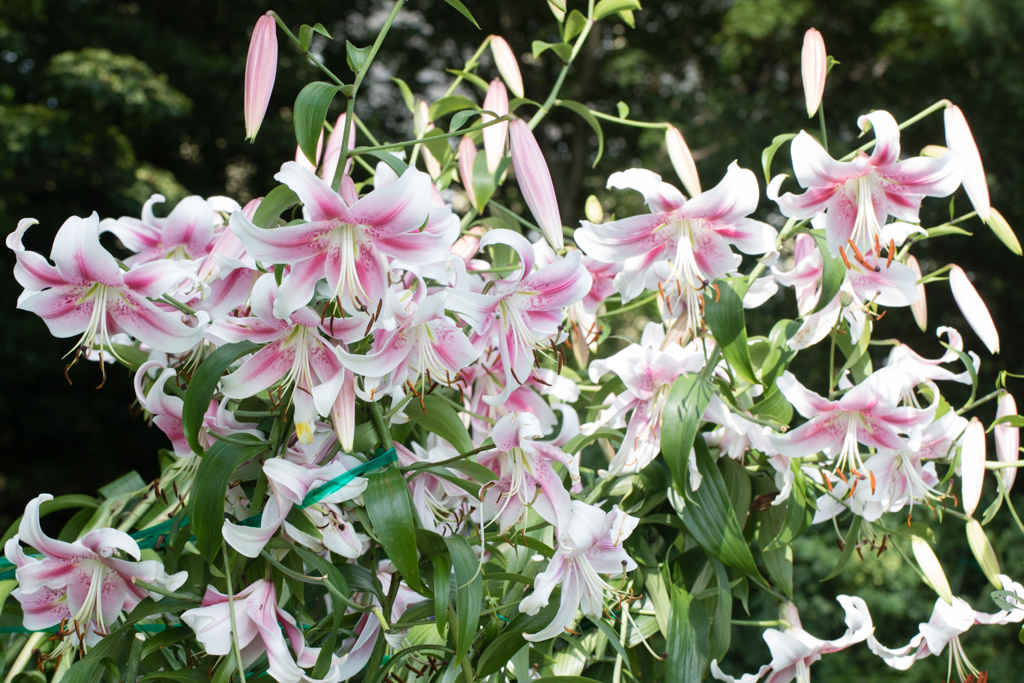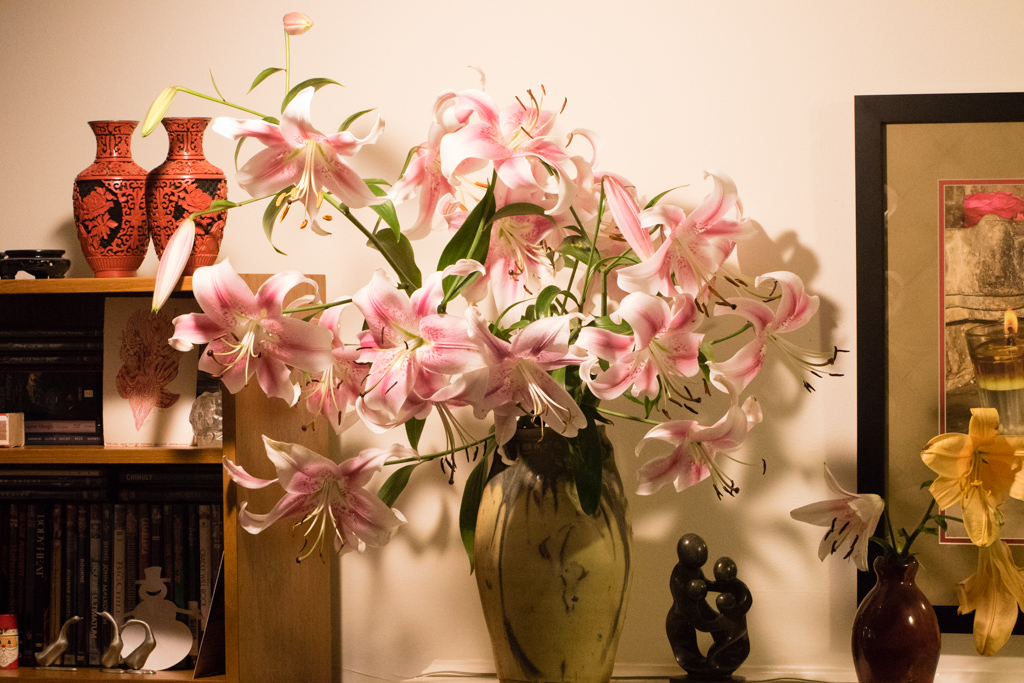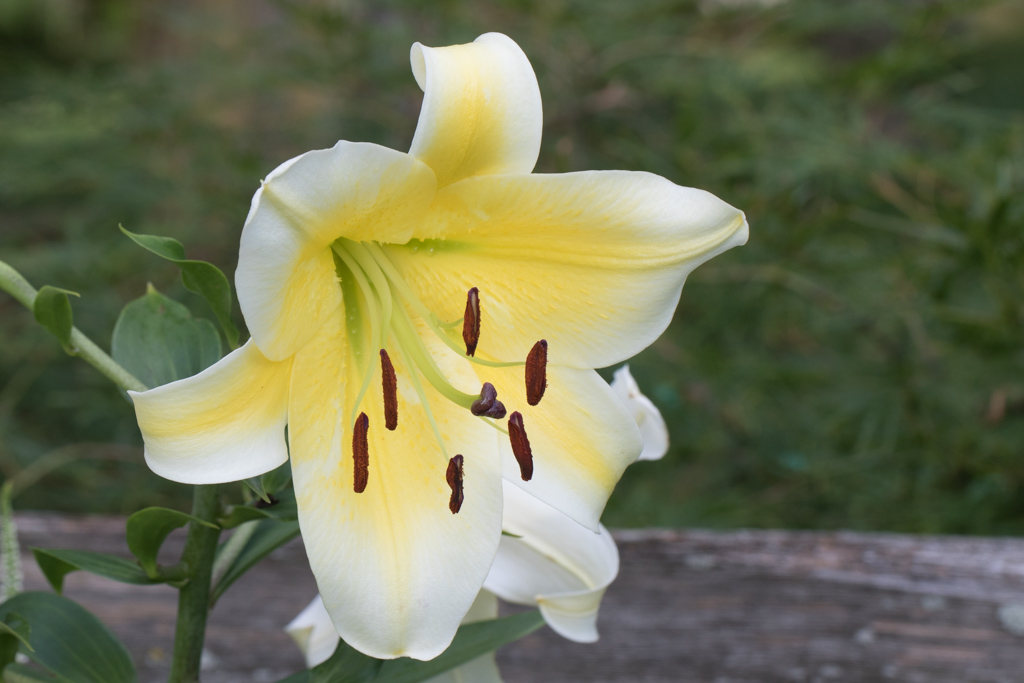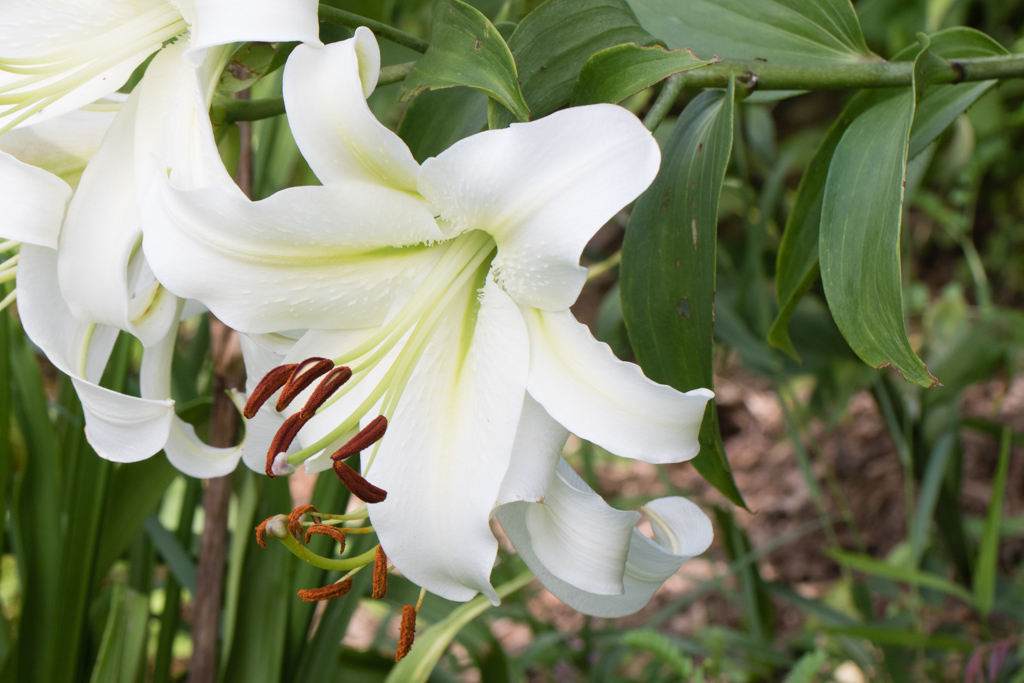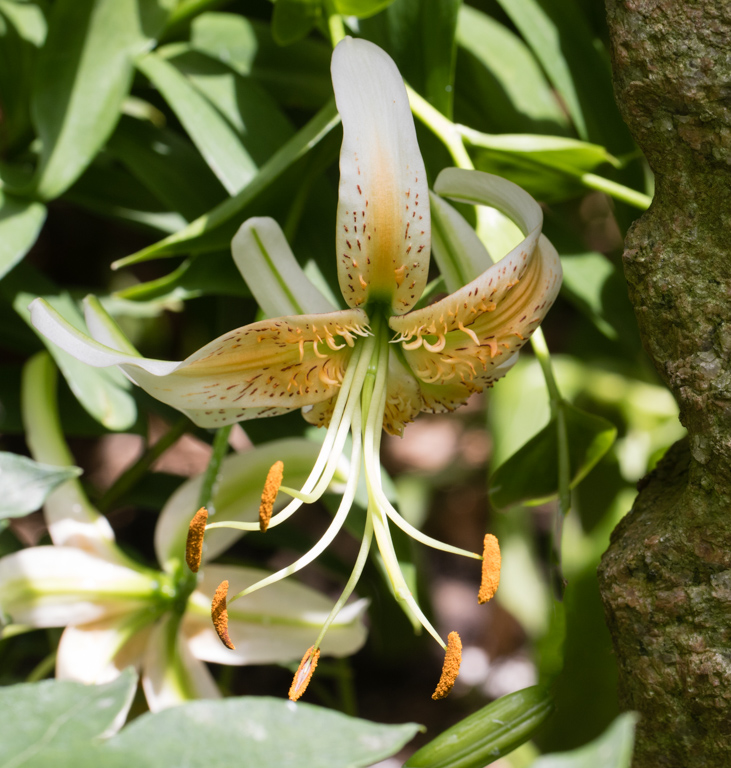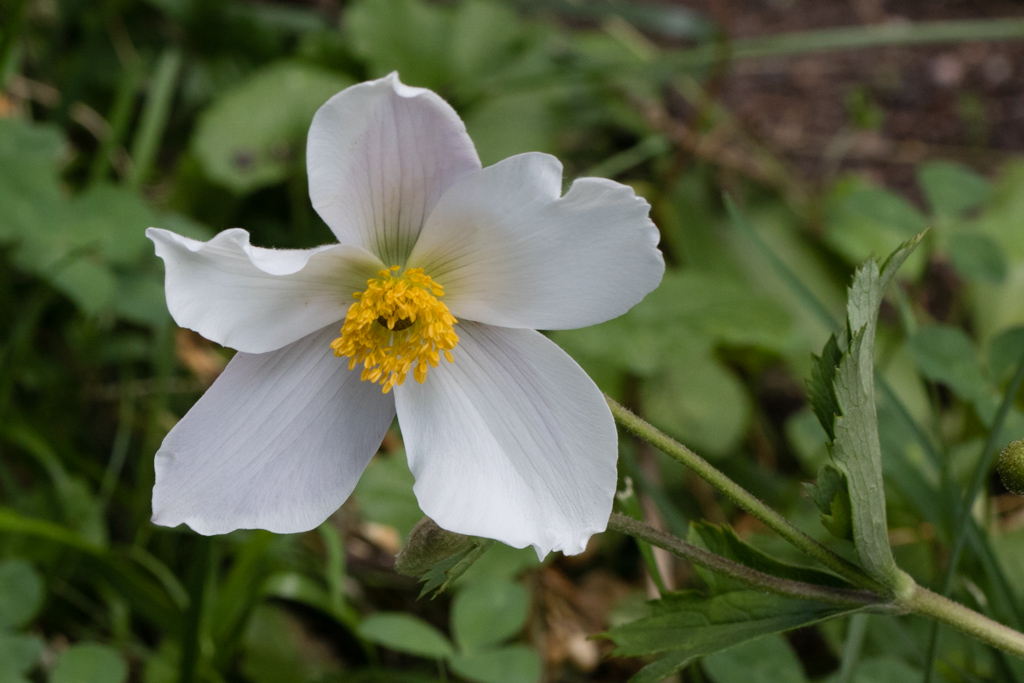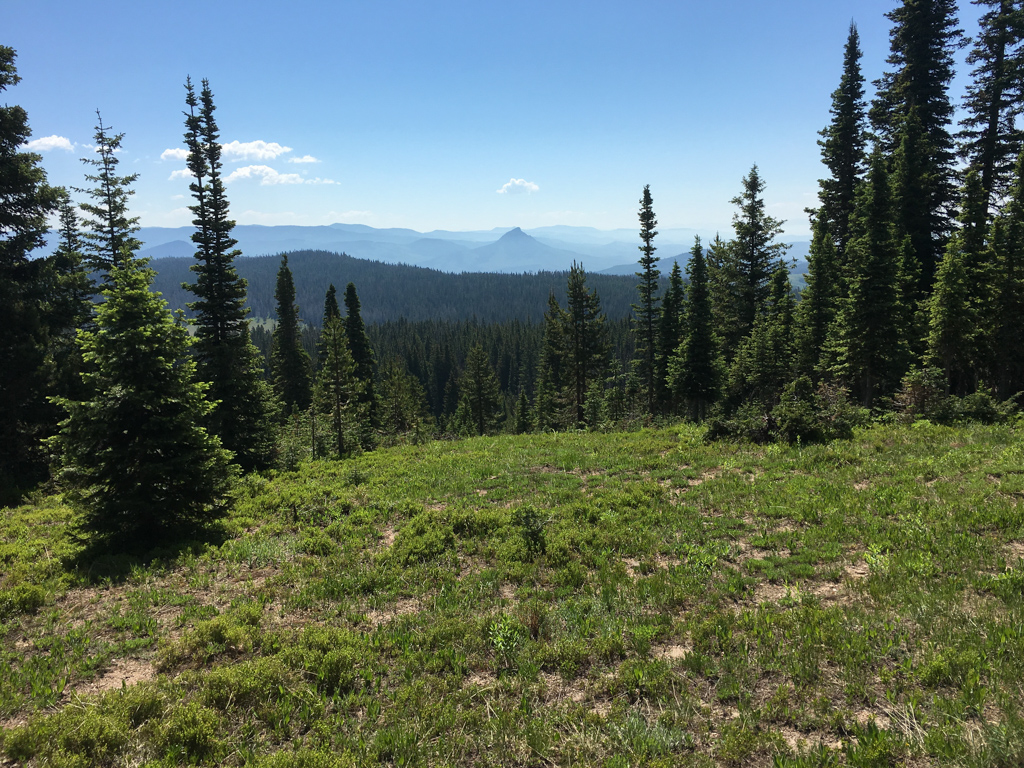It has been a generally hot and dry (read depressing) summer for our garden). In early August we awoke to find that we had drawn down the well with watering and so had to forego our normal watering plan. So my looks around the garden prior to Garden Blogger’s Bloom Day were fewer than they might otherwise have been. We did still water Beth’s new raised bed and the Nasturtiums and Calendulas have responded by blooming all summer long and into the Fall.
Many of the other flowers in bloom are a testament to how well some species can survive in adversity.
Venturing out onto our ultra-dry hillside which never gets watered at all anymore, I found several champions of the survival school.
Notice the spider on the Lemon Queen and it’s very adaptive coloration.
The butterflies are also very attracted to Lemon Queen.
I also saw a lovely Monarch Butterfly on the Tithonia in the vegetable garden.
One very noteworthy Fall-blooming flower is the Sedum ‘Autumn Joy’. I’m becoming more of a fan every year and it’s a good thing because it keeps spreading of its own volition.
Another fall bloomer was a bit of a surprise. This Sweet Autumn Clematis was something I pulled out three years ago and I was surprised to see it return in two separate places this year.
It’s a lovely flower but can get too aggressive if left to its own devices. I will probably try to transplant it to the woods.
In the alpine beds I have two erodiums that are returning to bloom right now.
In the greenhouse I have just finished restarting all the oxalis. At the same time the Bulbine has come back into flower.
And one of the cyclamens has taken on a very distinctive flowering by simply spilling over the edge of the pot with a great many flowers and no leaves at all.
Lastly just to note that man (or woman) does not live by flowers alone. The raspberries are joining the apples as delectable fruits to be harvested this month.
Garden Blogger’s Bloom Day August 2016
I find myself at the beach for this Garden Blogger’s Bloom Day, but before leaving I snapped a few shots of the flowering activity around our hillside. The gentian pictured above is a vigorous spreader in the Alpine bed that is a reliable harbinger of fall. The feathery insides of the flower make it one of the prettiest flowers I know.
The rest of the yard is dominated by the hardy annuals and sturdy perennials that can make it through a dry Maryland summer. A great example is the state flower, Black-eyed Susans, that dominates our front bed.
In the vegetable garden we often grow Mexican Sunflower (Sithonia) which are very attractive to butterflies.
There a number of plants that deserve special praise for returning one or more times during the summer.
The salvia is not supposed to be hardy in our area, but it has returned reliably for 5 years now.
The two lobelias, red and blue, are winners for an August garden.
Amongst the shrubs, the Hydrangea ‘Limelight makes a long and lovely showing.
From the greenhouse a number of the formosa lilies are in full flower.
And the small Herbertia texensis is putting out it’s complex flowers.
Let me close, because the beach is calling, with a wildlife image from the garden. I found this remarkably lovely caterpillar on a tree peony leaf.
Garden Blogger’s Bloom Day July 2016
Well, if you had to pick a theme flower for this month’s Garden Blogger’s Bloom Day it would the lilies. Despite the dry weather we have been experiencing, they are exploding all over the yard, especially the hybrids between orientals and trumpets (aka orienpets). They are tall, fragrant, floriferous, and individually stunning.
In the house they make quite a display too.
Here are some others of the lily orienpet persuasion.
Of course, even the old-fashioned orientals are pretty spectacular.
And then a new one added to collection this year is Lilium henryii hybrid.
There are course still many annuals and some of the standard perennials, but one of the species that has asked for special recognition is the Crocosmia. These wonderful bulbs from the iris family are durable, productive and beautiful, year after year.
Another new plant for us is the popular anemone ‘Wild Swan’.
It is especially characterized by the purple markings on the back of the petals.
In the greenhouse we have several noteworthy arrivals. First a very unusual Pineapple Lily.
This is only found in the wild between 7000′ and 8000′ in South Africa. At some point I might experiment with growing it outside.
Also from South Africa is member of the Amaryllis family, Cyrtanthus elatus x montanus.
A little Cyclamen is flowering from seed planted in 2013.
And a welcome returnee is this rain lily.
One of the fun things for me is finding the unusual animals that populate the yard, if you take the time to notice them. Last week it was this wonderful dime-sized spider that caught my eye.
A Higher State (Steppe to Alpine)
We just returned last week from a spectacular trip to Colorado that was focused on the North American Rock Garden Society‘s (NARGS) annual meeting. The theme was ‘A Higher State — Steppe to Alpine’ and it was in two locations, the Denver Botanic Garden and Steamboat Springs over 5 days. It had been a while since we had been to Colorado, so we met with friends and family in Boulder and Golden beforehand. I’ll try to give a brief overview of what was a wonderful and relaxing exploration of mountain wildflowers.
Hiking just outside of Boulder we encountered this lovely Calochortus.
The NARGS meeting began at the Denver Botanic Garden where we got a personalized tour of the rock gardens by Mike Kintgen who oversees the Alpine collection.
Their garden features a crevice garden which has been established for several years now (long enough to see several successful cushions)
They manage to grow the wonderful Devil’s Claw that we first saw in the Dolomites last year.
The Denver Botanic Gardens are not to be missed if you are in Denver. In this season they have a spectacular display of Foxtail Lilies.
On our way to Steamboat Springs we stopped at the Betty Ford Alpine Gardens in Vail which has newly constructed tufa wall for optimum planting of tiny alpines.
And the outside part of the gardens is quite nice as well.
In Steamboat Springs we visited local gardens including the Yampa River Botanic Park which right along the Yampa River in a very pretty setting. They have built a stunning crevice garden there.
I fell in love with a little Stachys planted in one of the crevice locations.
We also took several hikes in the trails surrounding Steamboat Springs. We drove out through countryside that really summed up what steppes are all about.
Just along the side of the road we saw beautiful Lewisia and Shooting Stars.
One stop near a trailhead into the Zirkel Wilderness area produced a bevy of these very small Ladyslipper Orchids
We stayed a few days past the conference and on the last day of hiking we walked up a ridge near the Rabbit Ears pass area. The views were excellent, but it was remarkable how you had to pay close attention to see that the hillside was covered with wildflower treasures.
And a final sighting on this ridge was a very nice ground orchid.
All in all, a wonderful trip, with a suitcase full of tiny treasures brought back to Maryland from the plant sales at the conference. My thanks to Laporte Avenue Nursery and Sunscapes Rare Plant Nursery.
Also, I should mention that the Denver Botanic Garden has published a very nice book on this region of the world (and similar) entitled ‘Steppes: The Plants and Ecology of the World’s Semi-arid Regions‘. Check it out…
Garden Blogger’s Bloom Day June 2016
Ok, this is way late for Garden Blogger’s Bloom Day. No Excuses. Everyone has gardens to build, weed, water, and harvest. But what really slows me down in posting is when I find a lovely flower that I acquired years ago and can’t figure out what the name is. And that leads me to the internet and well, you know how that goes. One thing leads to another and pretty soon you are buying another few plants instead of posting about the ones you have.
Anyway here are some of the flowers that I should have been sharing. Lillies and Iris are foremost. The Spuria Iris are some of my favorites.
The Spuria are generally pretty tall, but Shelford Giant is especially high up before it flowers.
I used to focus on the bearded Iris but I’ve found that many of the other species Iris are more reliable and enjoyable. I’ve never had the Iris borers focus on the other species the way they can on the bearded hybrids. In particular the Japanese Iris have a way of making nice clumps in the perennial gardens.
A new Japanese Iris for us this year is this four-foot tall specimen from Plant Delights.
The Blackout Lillies are creating their normal smashing display of vibrant dark red.
And in anticipation of setting a new height record for us the Trumpet Hybrid Pink Perfection is now higher than the 8 foot piece of granite in our Monument Bed.
Our potted lily wanna-be from the Amazon is in full flower at the moment.
I need to single out the last of the Arisaemas now in fully display. Both A. fargesii and A. candidssum took until June 4th before they showed their first pointed tips coming out of the soil. I especially love the pink of the A. candidissums.
Just a few other shots from around the yard before I go…
And let me close with another gem from the greenhouse…
Garden Blogger’s Bloom Day May 2016
Ok, it’s Garden Blogger’s Bloom Day for May and I’m already late (again). Everything is flowering (or so it seems). The peonies, iris, azaleas, rhododendrons, alliums, and so on. Let me share some of the main headliners and then get to some of the more unusual flowers.
Rhododendrons are represented by three of our standards. First the ultra-reliable R. chionoides which spends more and more of its time lying on the ground with various prostrate branches.
Then a scintillating pink that we have mixed into our camellia bed.
And I always have to share one of my favorites, R. ‘Viscosepala’, which has a magnificent fragrance.
This was the happy result of crossing R. molle and R. viscosum in 1844 at the famous Waterer nursery at Knaphill in England. I think it deserves more recognition. You can sit on the deck in the evening and smell this honeysuckle-like fragrance surrounding you.
The peonies always go through a progression of tree peonies to species to Itoh hyrids to herbaceous. The tree peonies and species types are just finishing now after serveral weeks of simply splendid flowers.
And the Itoh hybrids are lovely to look at right now.
The unopened bud of the Itoh hybrid ‘Sequestered Sunshine’ looks like a giant rose.
The first large bearded Iris are in bloom now and I just noticed a number of flowers on the Japanese Roof Iris yesterday.
Now let’s explore some of the less common flowers around the yard.
The Lamium orvala never fails to elicit comments when I point out the orchid-like flowers hidden under its leaves.
In one of the shade beds I see that one instance of the Rue Anemone has semi-double flowers that also seem to be bigger than its relatives.
In the front bed my planting of Dianthus spiculifolius in the large tufa rock seems to have taken hold.
Also in the front yard I had planted a Snow Poppy several years ago. It has spread but I had never seen it flower. Until this year.
The Snow Poppies are in a shady area near where the Woods Poppies (Stylophorum diphyllum) have long since taken over, and where the large Japanese Maple limits the sun and moisture in the summer time. I’m happy to have them spread at a reasonable pace.
At the GreenSprings Garden Plant Sale on Saturday I picked up a very nice little Calanthe hybrid orchid for the monument bed.
As we walk back to the Alpine garden I discovered a little ornithogalum growing with the little alpines and I couldn’t imagine how it got there until I reread my bulb order from last year. Ornitogalum exscapum is described as compact and flowering from the base and indeed that seems to be the case so far.
Nearby two of the Lewisia are in bloom.
And in the trough in front of the greenhouse one of my favorite campanula relatives is just coming into flower.
This makes a compact little cushion that is a wonderful example of why I like growing alpines. That’s a little Dianthus alpina that is showing nearby.
And in the Greenhouse I was delighted to discover last week that two of the three rare Scillas that I planted last January are starting to grow.
These are very beautiful plants and I’m hoping to see flowers before they go dormant for the summer.
Let me close with an Iris relative, Gelasine elongata, also growing in the greenhouse.
This flowers at the end of a 2 ft. long stalk. It is said to be marginally hardy here so I may give it a try outside.
Seed Tales
I was pleased to see a bud coming out of my planting of Tulipa sprengeri this past week. But what emerged is very likely Zephyranthes dichromata. That’s pretty much par for the course on starting some of these unusual plants from seed. You can wait years for a seedling to emerge and then discover that it was either a mislabeled package or some friendly neighboring pot contributed some viable seed. It’s likely that the Zephyranthes jumped from a neighboring pot because they do seed freely. But then there are the successful outcomes like the big Paradisea that is just finishing in the greenhouse right now.
This is a beautiful lily-like plant more than 2 feet high that came from seed distributed by the Pacific Bulb Society in the spring of 2013. It grows wild in the mountains of Portugal and might be barely hardy here. Another successful seed sowing from the PBS in 2013 was Dichelostemma multiflorum which grows wild in California.
I’ve planted a lot of seeds over the past few years and managed to lose of lot of my seedlings last year when the water timer failed while we were on vacation. I’ve kept all those pots just in case, but decided last week to go through the hundreds of pots and reclaim the soil and pots.
I was delighted to find that some of those pots had seedlings just starting.
This all serves as a reminder that you have to patient to allow good things to happen. Another sort of patience comes with waiting for the first flowers. Four years ago I bought a tiny little seedling of Paeonia rockii from Wrightman Alpines. It has taken until this year to produce it’s first flowers. I think you will agree that it was worth the wait.
Another delightful species Peony that is flowering right now was obtained from Plant Delights
So returning to topic of planting seeds I should note that many of the seeds come up in abundance. They are often very cute as they so immediately resemble the plants that they will eventually become.

Phyteuma scheuchzeri seedlings (BotanyCa)

Gentiana dahurica seedlings (BotanyCa)
Altogether, looking at the three alpine seed exchanges that I participate in, the results are just short of 50% of the seeds successfully started so far. In other words, so far, so good.
The other part of the seed topic is collecting the ones that are appearing right now. Many of the spring ephemerals are putting out seeds in quantity now.
Often the spring emphemerals have elaiosomes on the seeds that make them attractive to ants. So there is a brief 3-5 day window when you can just knock off the seeds to collect them. Otherwise, if they fall, the ants will gather them up and take them home for planting.
And, of course, every seed is not only a potential new plant, but also acts as currency if you are involved in seed exchanges.
Let me close with a few more of the flowers that have bloomed over the past two weeks.
And lastly a beautiful new Allium from Odyssey Bulbs
Garden Blogger’s Bloom Day April 2016
Well for this Garden Blogger’s Bloom Day there is no difficulty with finding things in flower. April is a fantastic time for a Maryland gardener. Just a few days ago we were assessing the damage from killing frosts (Toad lilies and the asian Disporum are surprisingly vulnerable), but right now we are relishing the blooms. Daffodils and Tulips headline the show. For example, there is this new addition to the woods.
And old favorites in the front bed.
A naturalized tulip for woodland areas.
And this new addition from Odyssey Bulbs last year.
But the various smaller plants always capture my attention.
Erythroniums are at their peak right now.
Close by is a new Scilla relative that we added this past year (also from Odyssey Bulbs).
Note the lovely blue anthers.
There are also the epimediums, seemingly delicate plants that are oh-so-hardy.
In this case the leaves are as special as the flowers.
An aquilegia that my eldest son grew from a Scottish Rock Garden Society seed distribution begs for attention right now (very dwarf).
And there is a Muscari that I got from Brent and becky last year that is growing in very difficult place between maple roots and an American Holly.
In the camellia bed we find a lovely little corydalis that has lasted for several season now (hard to do with the blue ones).
The name comes from the leaves, not the flowers.
Nearby is one of my favorite trilliums.
Also in the Camellia bed is one of the tiniest Hepaticas I have seen, the result of several seedlings I planted from Hillside Nursery.
The Alpine bed features a very nice Daphne, that has all the fragrance that you expect from a Daphne.
And in small trough #2, there is the most beautiful little phlox that is doing alll that you expect from a phlox.
And from the greenhouse there are a couple of plants that have come into the house recently.
This small Amaryllis-want-to-be is also called the Barbados Striped Lily though it is actually from Brazil and it is multiplying in it’s small pot like mad.
And a south african plant originally purchased from Annie’s Annuals.
This is at the tip of two-foot long stalks this year.
Finally, I should mention the various flowering trees. This is right now the peak of the crossover between the various fruit trees, crabapples and cherries, giving way to the dogwoods.
The apple trees in the orchard are in the midst of one of the finest bloom cycles I have seen.
These are the highlights on Ball Rd. What is growing in your garden?






























